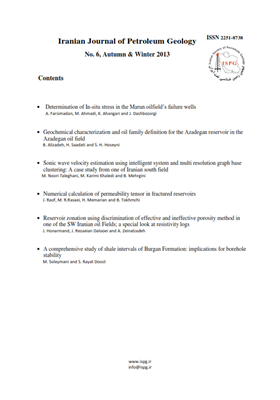Reservoir zonation using discrimination of effective and ineffective porosity method in one of the SW Iranian oil Fields; a special look at resistivity logs
Subject Areas :جواد هنرمند 1 , ژیلا رضائیان دلوئی 2 , ارسلان زینل زاده 3
1 -
2 -
3 -
Keywords: Asmari Formation Effective porosity Resistivity log Reservoir zonation ,
Abstract :
Abstract In this paper, core samples from Upper carbonates (Miocene age) of the Asmari Formation in one of the SW Iranian oil fields were studied in macro and microscopic scale. Subsequently, results from core and thin section studies compared with core porosity and permeability and petrophysical wireline logs, especially resistivity logs. Due to texture variation (mudstone to grainstone) and diagenetic events (dolomitization, dissolution, calcite and anhydrite cementation), porosity type and percentage changed in wide range in this formation. This study showed that resistivity logs could be used as an effective tool to distinct effective and ineffective-bearing zones. High permeability intervals have relatively high deep resistivity and high separation between deep and shallow resistivity logs, whereas non-reservoir intervals have low resistivity and very low separation between deep and shallow resistivity. Based on this study, studied carbonate interval of the Asmari Formation was divided into 13 zones. Using separation of deep and shallow resistivity logs, flow zones could be correlated throughout the studied field


